As usual, TV8 provides the logical explanation. I guess I’ll go with..........MODERN! Thanks Paul.Because an isolator on the top and bottom is the more modern way to mount a body to a frame. The old method (original to your Willys and used on many American vehicles until around the 1960s) is the single isolator. The vendors sell the kits this way because they are catering toward original restoration.
You are using an out of date browser. It may not display this or other websites correctly.
You should upgrade or use an alternative browser.
You should upgrade or use an alternative browser.
‘50 Wagon/S-10 chassis project
- Thread starter AgarAgar
- Start date
edgy
Sharpest Tool
Thank you so much for posting this. I thought my memory was bad, because I only had one isolator per mount that came off originally. The posts I have seen in the forum seemed to indicate that 2 per mount location was typical. This helps a ton. It means I don't have to adjust my meds.Because an isolator on the top and bottom is the more modern way to mount a body to a frame. The old method (original to your Willys and used on many American vehicles until around the 1960s) is the single isolator. The vendors sell the kits this way because they are catering toward original restoration.
Ed, this is the ultimate continuing education undertaking. The “watchers” like TurbofireV8 keep us on the right track by their very nature.Thank you so much for posting this. I thought my memory was bad, because I only had one isolator per mount that came off originally. The posts I have seen in the forum seemed to indicate that 2 per mount location was typical. This helps a ton. It means I don't have to adjust my meds.
Gojeep
Well Oiled
Double rubbers allow a lot more twist, twice as much, on the frame without affecting the body. Far less fatigue cracks that way.
Yogi Berra famously said “When you come to a fork in the road, take it!”. My road to body mounts was forked so I took it, and it led me to bumper brackets. The steel for the body mounts was 2 hours away but I had enough leftovers to take on some brackets. Besides, I was tired of banging my kneecaps on the S-10’s overbuilt frame horns. The layout started with the repro splash pan/grille relationship and ended with a WAG and some tape. The wheel of death established the top line and the sawzall finished whacking off the horns. Funny thing though, the vertical part of the horns will be repurposed for a pair of body mounts!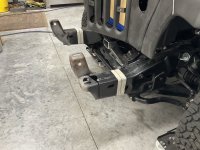
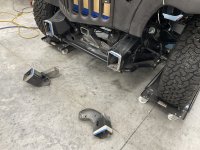 With the frame de-horned, the scrap pile directed me to once again use the 2x3”x.25 wall tubing. And to inspire the Voyager I snagged a chunk of heavy walled C-channel for the vertical portion of the bumper brackets. To keep the layout simple, the top of the C-channel would be equal to the height of the inside of the bumper. If it was drawn correctly, the splash pan will have enough slope to insure drainage. The tubing was cut to fit inside the frame cavity and tapped for .375” bolts.
With the frame de-horned, the scrap pile directed me to once again use the 2x3”x.25 wall tubing. And to inspire the Voyager I snagged a chunk of heavy walled C-channel for the vertical portion of the bumper brackets. To keep the layout simple, the top of the C-channel would be equal to the height of the inside of the bumper. If it was drawn correctly, the splash pan will have enough slope to insure drainage. The tubing was cut to fit inside the frame cavity and tapped for .375” bolts.
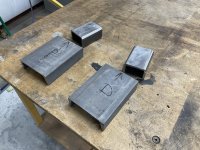
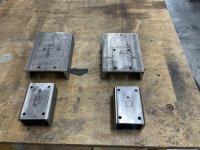 OK, that looks stout, now let’s fit them and glue them in place. Great care was taken to install the fillers plumb and parallel so no shims would be required to compensate.
OK, that looks stout, now let’s fit them and glue them in place. Great care was taken to install the fillers plumb and parallel so no shims would be required to compensate.
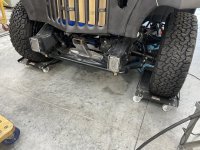
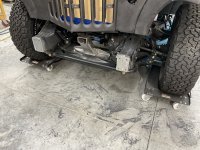 Then the channels were test fit and rechecked for alignment.
Then the channels were test fit and rechecked for alignment.
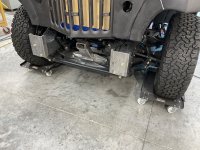
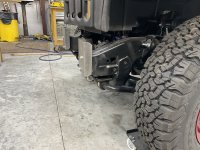 Then it was time for pattern making and lots of fidgeting around until the bumper was properly aligned in 3 dimensions. I like patterning but fidgeting is a tad too tedious for a hobbyist, so I lashed the bumper to a mobile vertical belt sander that was collecting dust over in the corner. The machine weight provided enough heft to stay in place after every fidget. Once I was happy with the compromises I strapped the rig in place for patterning, hoping that one pattern would fit both sides.
Then it was time for pattern making and lots of fidgeting around until the bumper was properly aligned in 3 dimensions. I like patterning but fidgeting is a tad too tedious for a hobbyist, so I lashed the bumper to a mobile vertical belt sander that was collecting dust over in the corner. The machine weight provided enough heft to stay in place after every fidget. Once I was happy with the compromises I strapped the rig in place for patterning, hoping that one pattern would fit both sides.
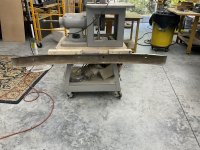
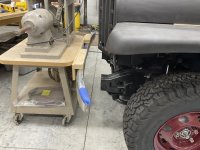
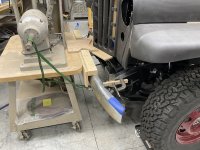
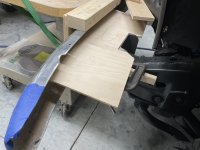 With all the drawing done, it was time to mangle some metal. I decided to dedicate one flat bar to each set of three bolt holes in the bumper. It would need to match the inner curvature fairly close in order to prevent distorting the restored chrome bumper. After the .25x1.5” CR was cut to length I chucked it in the vise and gave it ”whut fer” and it just snickered! I had pulled on the 2’ long bar at close to my capacity and nothing happened, except maybe the 4” vice was crying uncle. So I grabbed both bars and the pattern and started walking around the shop looking for something stout enough to take the abuse. My walk continued outside to the tractor implement hitch which had the right geometry and heft for my bending task. A check against the pattern looked good so I drilled .5” holes to match the bumper.
With all the drawing done, it was time to mangle some metal. I decided to dedicate one flat bar to each set of three bolt holes in the bumper. It would need to match the inner curvature fairly close in order to prevent distorting the restored chrome bumper. After the .25x1.5” CR was cut to length I chucked it in the vise and gave it ”whut fer” and it just snickered! I had pulled on the 2’ long bar at close to my capacity and nothing happened, except maybe the 4” vice was crying uncle. So I grabbed both bars and the pattern and started walking around the shop looking for something stout enough to take the abuse. My walk continued outside to the tractor implement hitch which had the right geometry and heft for my bending task. A check against the pattern looked good so I drilled .5” holes to match the bumper.
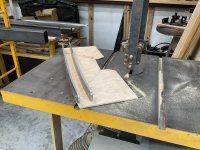 Next task was to cut and bend the horizontal components connecting the two verticals. The bends were too steep for the tractor jig so I used the slice-bend-weld method. These pieces are bolted with .5” G8 bolts to the frame channel and welded to the curved bumper backer. The fixture maintained the bumper location for fine-tuning and tack welding.
Next task was to cut and bend the horizontal components connecting the two verticals. The bends were too steep for the tractor jig so I used the slice-bend-weld method. These pieces are bolted with .5” G8 bolts to the frame channel and welded to the curved bumper backer. The fixture maintained the bumper location for fine-tuning and tack welding.
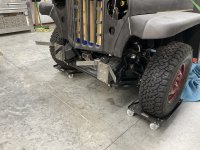
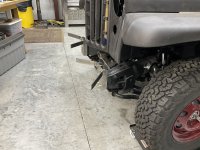
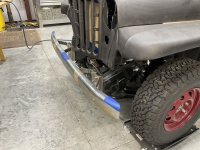 So far, so good. Now it’s time to overbuild. I decided to add a 1.25” round tube angled brace from the backer to the vertical channel. The plan called for welding to the backer (which is bolted to the bumper) and bolting to the channel. That required an overlay plate that bolted to the channel as a base for the brace.
So far, so good. Now it’s time to overbuild. I decided to add a 1.25” round tube angled brace from the backer to the vertical channel. The plan called for welding to the backer (which is bolted to the bumper) and bolting to the channel. That required an overlay plate that bolted to the channel as a base for the brace.
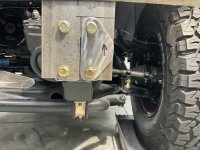 A little cutting, a little welding and the braces were in place. Let’s take a look.....
A little cutting, a little welding and the braces were in place. Let’s take a look.....
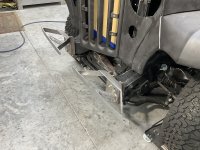
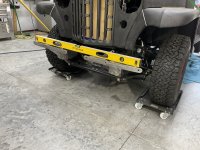 Alright, properly overdone. Time to bolt the bumper in place to check fit. I supposed you noticed the additional top gusset I glued on while the gluin was good. Behold.......
Alright, properly overdone. Time to bolt the bumper in place to check fit. I supposed you noticed the additional top gusset I glued on while the gluin was good. Behold.......
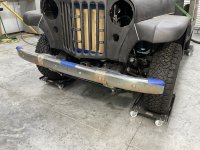 Well that was fun! Next up, fitting the splash pan. Thanks for stopping by.
Well that was fun! Next up, fitting the splash pan. Thanks for stopping by.

 With the frame de-horned, the scrap pile directed me to once again use the 2x3”x.25 wall tubing. And to inspire the Voyager I snagged a chunk of heavy walled C-channel for the vertical portion of the bumper brackets. To keep the layout simple, the top of the C-channel would be equal to the height of the inside of the bumper. If it was drawn correctly, the splash pan will have enough slope to insure drainage. The tubing was cut to fit inside the frame cavity and tapped for .375” bolts.
With the frame de-horned, the scrap pile directed me to once again use the 2x3”x.25 wall tubing. And to inspire the Voyager I snagged a chunk of heavy walled C-channel for the vertical portion of the bumper brackets. To keep the layout simple, the top of the C-channel would be equal to the height of the inside of the bumper. If it was drawn correctly, the splash pan will have enough slope to insure drainage. The tubing was cut to fit inside the frame cavity and tapped for .375” bolts.
 OK, that looks stout, now let’s fit them and glue them in place. Great care was taken to install the fillers plumb and parallel so no shims would be required to compensate.
OK, that looks stout, now let’s fit them and glue them in place. Great care was taken to install the fillers plumb and parallel so no shims would be required to compensate.
 Then the channels were test fit and rechecked for alignment.
Then the channels were test fit and rechecked for alignment.
 Then it was time for pattern making and lots of fidgeting around until the bumper was properly aligned in 3 dimensions. I like patterning but fidgeting is a tad too tedious for a hobbyist, so I lashed the bumper to a mobile vertical belt sander that was collecting dust over in the corner. The machine weight provided enough heft to stay in place after every fidget. Once I was happy with the compromises I strapped the rig in place for patterning, hoping that one pattern would fit both sides.
Then it was time for pattern making and lots of fidgeting around until the bumper was properly aligned in 3 dimensions. I like patterning but fidgeting is a tad too tedious for a hobbyist, so I lashed the bumper to a mobile vertical belt sander that was collecting dust over in the corner. The machine weight provided enough heft to stay in place after every fidget. Once I was happy with the compromises I strapped the rig in place for patterning, hoping that one pattern would fit both sides.


 With all the drawing done, it was time to mangle some metal. I decided to dedicate one flat bar to each set of three bolt holes in the bumper. It would need to match the inner curvature fairly close in order to prevent distorting the restored chrome bumper. After the .25x1.5” CR was cut to length I chucked it in the vise and gave it ”whut fer” and it just snickered! I had pulled on the 2’ long bar at close to my capacity and nothing happened, except maybe the 4” vice was crying uncle. So I grabbed both bars and the pattern and started walking around the shop looking for something stout enough to take the abuse. My walk continued outside to the tractor implement hitch which had the right geometry and heft for my bending task. A check against the pattern looked good so I drilled .5” holes to match the bumper.
With all the drawing done, it was time to mangle some metal. I decided to dedicate one flat bar to each set of three bolt holes in the bumper. It would need to match the inner curvature fairly close in order to prevent distorting the restored chrome bumper. After the .25x1.5” CR was cut to length I chucked it in the vise and gave it ”whut fer” and it just snickered! I had pulled on the 2’ long bar at close to my capacity and nothing happened, except maybe the 4” vice was crying uncle. So I grabbed both bars and the pattern and started walking around the shop looking for something stout enough to take the abuse. My walk continued outside to the tractor implement hitch which had the right geometry and heft for my bending task. A check against the pattern looked good so I drilled .5” holes to match the bumper. Next task was to cut and bend the horizontal components connecting the two verticals. The bends were too steep for the tractor jig so I used the slice-bend-weld method. These pieces are bolted with .5” G8 bolts to the frame channel and welded to the curved bumper backer. The fixture maintained the bumper location for fine-tuning and tack welding.
Next task was to cut and bend the horizontal components connecting the two verticals. The bends were too steep for the tractor jig so I used the slice-bend-weld method. These pieces are bolted with .5” G8 bolts to the frame channel and welded to the curved bumper backer. The fixture maintained the bumper location for fine-tuning and tack welding.

 So far, so good. Now it’s time to overbuild. I decided to add a 1.25” round tube angled brace from the backer to the vertical channel. The plan called for welding to the backer (which is bolted to the bumper) and bolting to the channel. That required an overlay plate that bolted to the channel as a base for the brace.
So far, so good. Now it’s time to overbuild. I decided to add a 1.25” round tube angled brace from the backer to the vertical channel. The plan called for welding to the backer (which is bolted to the bumper) and bolting to the channel. That required an overlay plate that bolted to the channel as a base for the brace. A little cutting, a little welding and the braces were in place. Let’s take a look.....
A little cutting, a little welding and the braces were in place. Let’s take a look.....
 Alright, properly overdone. Time to bolt the bumper in place to check fit. I supposed you noticed the additional top gusset I glued on while the gluin was good. Behold.......
Alright, properly overdone. Time to bolt the bumper in place to check fit. I supposed you noticed the additional top gusset I glued on while the gluin was good. Behold....... Well that was fun! Next up, fitting the splash pan. Thanks for stopping by.
Well that was fun! Next up, fitting the splash pan. Thanks for stopping by.
Last edited:
Thanks Tim for your kind words and support. I’m coming up on one year into the project and I suspect there is another year to go, which is child’s play compared to Gojeep @a decade plus........
Your "scrap" pile is pretty impressive. Overall this build is going really well, great progress. Really like the updates and ingenuity, looking at the different ways to get thru the build.
Yeah mine is majorly stalled out, I've had my pick up 26 years, luckily the cab and sheet metal is inside a shipping container so those parts are pretty safe.
So I live vicariously through builds like yours. Really gets us kind of folks trying to figure out a way to get restarted.
My kids are pretty young so not really a priority, but it will get sorted out eventually, my wife is really cool and knows that we both want to focus on the kids for a bit while they are young. We've both put some stuff like this off for a bit.
For now we just keep checking out all the cool stuff on OWF.
So I live vicariously through builds like yours. Really gets us kind of folks trying to figure out a way to get restarted.
My kids are pretty young so not really a priority, but it will get sorted out eventually, my wife is really cool and knows that we both want to focus on the kids for a bit while they are young. We've both put some stuff like this off for a bit.
For now we just keep checking out all the cool stuff on OWF.
VoyagerXll
Sharpest Tool
After seeing your approach to mounting the bumper I was so inspired that I ventured out to the shop with the idea that I would try to "organize" the mess I have created there. Man it was so hot in there that my inspiration quickly evaporated. I cut Rusty's knee knockers off shortly after starting the project. I cut them quite long to ensure not having to add to them at a later date.
When i get to the bumper step I will probably follow your lead. It appears that I "should" be able to get back Rusty in a week or so.
I enjoy watching you progress on your wagon
When i get to the bumper step I will probably follow your lead. It appears that I "should" be able to get back Rusty in a week or so.
I enjoy watching you progress on your wagon
POPS52
Well Oiled
Great metalogic work there. Well done brother.
That's great work. Appreciate the detail. I learned something.
Dang Stan, you went straight from frostbite to heatstroke! Keep them cows watered, stay cool, and thanks for your input.
After seeing your approach to mounting the bumper I was so inspired that I ventured out to the shop with the idea that I would try to "organize" the mess I have created there. Man it was so hot in there that my inspiration quickly evaporated. I cut Rusty's knee knockers off shortly after starting the project. I cut them quite long to ensure not having to add to them at a later date.
When i get to the bumper step I will probably follow your lead. It appears that I "should" be able to get back Rusty in a week or so.
I enjoy watching you progress on your wagon
Thanks Dan. The learning never stops on the OWF, and the surprises just keep coming.That's great work. Appreciate the detail. I learned something.
OLDWILLYSFORUM.COM - MAKERS OF THE WORLD'S MOST WELL-INFORMED WILLYS OWNERS
Well I guess there’s more than one way to skin a splash pan, and you can count on me to choose the least practical or popular way. I write that with zero knowledge of any other method, I just tend to get pulled in by considering all the abuse that flimsy panel might encounter. And if that weren’t enough to squeeze the brakes on further reading, this project is going to be presented in two parts!
The metal pan that came with Bruce had a long history of abuse and was barely hanging by a thread when I picked him up in Colorado last June. The driver’s front quarter had been crunched at some point and mostly repaired minus the splash pan. I was already shopping for splash pans on the way back to Florida. So I ordered a fiberglass pan from Jeepster Jim, advertised as “used” for $$$ plus shipping $$ and it soon arrived in just two layers of bubble wrap amazingly undamaged. It hadn’t been drilled so it probably wasn’t used but lord have mercy it was less rigid than a potato chip! Well I can’t imagine a scenario in which the splash pan DOESN’T get STEPPED ON! Hell, I’M PLANNING TO STEP ON IT! So there’s the challenge and the reason for the two-part thingy.
First, let‘s take a look at our store-bought masterpiece…….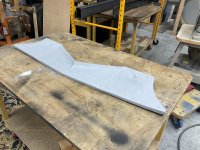
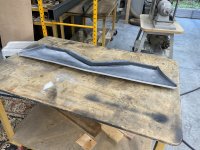
Too bad the glass guy didn’t take a couple of passes over this specimen with a chop gun. That might have retailed for $ but it would be worth $$ to the average Willysite. To me it’s just another task in a myriad of tasks that keeps my brain engaged. After a test fit to see if my bumper plan wrecked the splash pan plan (hah!) it appeared that the fit was reasonable and my goal of adequate drainage was reached. I noticed a nice hole in the lower flange of the grille below the parking light hole on both sides of the grille. The flange seemed strong enough to lash the pan to so I grabbed a strip of .312x3” aluminum I horked out of the $1-a-pound bin at my favorite metal monger last trip. After cutting it to 5”+/- x 2 pieces, I clamped it to my makeshift hammer brake and pounded a 15 degree bend into both pieces. I’m telling ya that .312” bar did NOT want to bend. That’s good, right? Then my devious side took the lead by drilling a legion of holes with the step drill, but only going halfway deep on the next-larger size. Just take a gander at the results…… What you see above is 8 funky countersunk holes, 2 holes for bolting to the grille flange, and one special hole for the exposed carriage bolt that the factory specified. Let’s keep moving to clear up the mystery countersunk holes. The drilled bars were then bolted to the grille flange with the long end pointed toward the bumper, The pan was then notched on each side to fit over the bent & drilled bars. The carriage bolt holes were then drilled and bolted. After that, the flange bolts were removed and the assembled unit was placed on the bench for marking. This crap is just too dry, let’s gawk at a picture……..
What you see above is 8 funky countersunk holes, 2 holes for bolting to the grille flange, and one special hole for the exposed carriage bolt that the factory specified. Let’s keep moving to clear up the mystery countersunk holes. The drilled bars were then bolted to the grille flange with the long end pointed toward the bumper, The pan was then notched on each side to fit over the bent & drilled bars. The carriage bolt holes were then drilled and bolted. After that, the flange bolts were removed and the assembled unit was placed on the bench for marking. This crap is just too dry, let’s gawk at a picture……..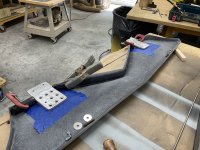 I wrote all that to write all this. Note that temporary dams have been clamped on both sides of the bars. The bars will be imbedded in a glob of MarineTex epoxy. The epoxy will squirt up through those 8 funky holes which will act as “rivets” when cured. Neat, huh? The blue tape will provide location accuracy and a temporary bolt will provide clamping pressure, acting against the earlier cut notch. Now here’s yet another trick, the clamping bolt MUST be drenched in paste wax so the epoxy won’t trap it. Behold the waxed bolts waiting to be shoved through a glob of epoxy…..
I wrote all that to write all this. Note that temporary dams have been clamped on both sides of the bars. The bars will be imbedded in a glob of MarineTex epoxy. The epoxy will squirt up through those 8 funky holes which will act as “rivets” when cured. Neat, huh? The blue tape will provide location accuracy and a temporary bolt will provide clamping pressure, acting against the earlier cut notch. Now here’s yet another trick, the clamping bolt MUST be drenched in paste wax so the epoxy won’t trap it. Behold the waxed bolts waiting to be shoved through a glob of epoxy…..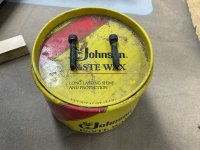
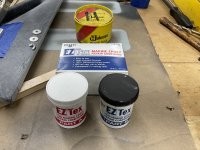 Let‘s see how that absurd plan worked out…….
Let‘s see how that absurd plan worked out…….
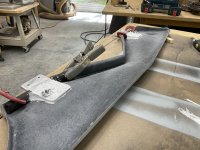 Ahh, perfect. Remove the dams, pull the bolts, and sand it purty. Next I focused on adding strength to the front edge. There was a piece of 1” steel tube w/.062” walls left over from making floor supports that fit the bill. It should be strong enough to hold the crooked pan straight in addition to some concealed brackets from the bumper bolts to the tube. Due to the radius molded into the bottom of the pan, some unconventional cutting and fitting and fastening was required. The two exposed bolts already drilled in the bumper will be the only exposed fasteners in the front edge. The steel tube was slit, bent, and welded to conform to the angled front edge. In order to line up with the existing bolt holes in the bumper, the pan lip had to be partially removed. I did the cutting with an air body saw, BUT with a helpful customization! A wide sawzall blade was death-wheeled to conform to the air saw chuck size. This is a good trick to add to your bag……
Ahh, perfect. Remove the dams, pull the bolts, and sand it purty. Next I focused on adding strength to the front edge. There was a piece of 1” steel tube w/.062” walls left over from making floor supports that fit the bill. It should be strong enough to hold the crooked pan straight in addition to some concealed brackets from the bumper bolts to the tube. Due to the radius molded into the bottom of the pan, some unconventional cutting and fitting and fastening was required. The two exposed bolts already drilled in the bumper will be the only exposed fasteners in the front edge. The steel tube was slit, bent, and welded to conform to the angled front edge. In order to line up with the existing bolt holes in the bumper, the pan lip had to be partially removed. I did the cutting with an air body saw, BUT with a helpful customization! A wide sawzall blade was death-wheeled to conform to the air saw chuck size. This is a good trick to add to your bag……
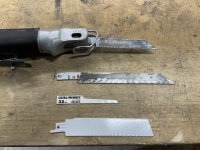 Now it was time to get on with fitting and drilling and gluing and riveting. I do love those rivets.
Now it was time to get on with fitting and drilling and gluing and riveting. I do love those rivets.
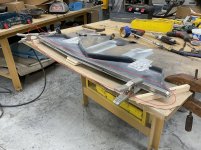 The area outlined in red shows the boogered up situation created by the necessary position of the tube. This will be purtied up later. Oh yeah, the tube ends were plugged with hardwood which made it easier to fit the complicated molding. Let’s get on with the riveting…….
The area outlined in red shows the boogered up situation created by the necessary position of the tube. This will be purtied up later. Oh yeah, the tube ends were plugged with hardwood which made it easier to fit the complicated molding. Let’s get on with the riveting…….
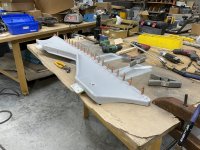 Now we need a form to cast some MarineTex along the front edge to finish it off. A strip of .5” x 1.5“ plywood would do nicely, and to keep the epoxy from sticking it was covered with a strip of packing tape which was then waxed……
Now we need a form to cast some MarineTex along the front edge to finish it off. A strip of .5” x 1.5“ plywood would do nicely, and to keep the epoxy from sticking it was covered with a strip of packing tape which was then waxed……
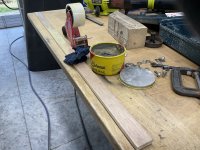 Nice! The tube was set in a bed of epoxy and the rivets were set. Then epoxy was generously applied to the front edge to fill in all the ugliness followed by lightly clamping the taped and waxed plywood caul. Then we wait…..
Nice! The tube was set in a bed of epoxy and the rivets were set. Then epoxy was generously applied to the front edge to fill in all the ugliness followed by lightly clamping the taped and waxed plywood caul. Then we wait…..
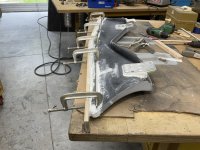 So far, so good. Four hours later, after an extended lunch, I pulled the clamps and caul off and sanded off everything that wasn’t needed. It turned out pretty good for a part that will never be seen! A bit more sanding and some spray bomb primer and then it was time for an extended dinner.
So far, so good. Four hours later, after an extended lunch, I pulled the clamps and caul off and sanded off everything that wasn’t needed. It turned out pretty good for a part that will never be seen! A bit more sanding and some spray bomb primer and then it was time for an extended dinner.
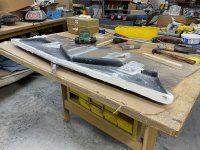
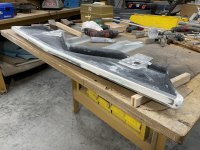
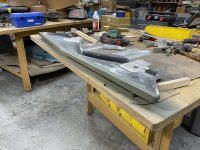
Next up, brackets connecting the tube to the bumper bolts, brackets from the bumper bracket bolts to the exposed carriage bolts, and reinforcing the center of the pan. Thanks for stopping by.
The metal pan that came with Bruce had a long history of abuse and was barely hanging by a thread when I picked him up in Colorado last June. The driver’s front quarter had been crunched at some point and mostly repaired minus the splash pan. I was already shopping for splash pans on the way back to Florida. So I ordered a fiberglass pan from Jeepster Jim, advertised as “used” for $$$ plus shipping $$ and it soon arrived in just two layers of bubble wrap amazingly undamaged. It hadn’t been drilled so it probably wasn’t used but lord have mercy it was less rigid than a potato chip! Well I can’t imagine a scenario in which the splash pan DOESN’T get STEPPED ON! Hell, I’M PLANNING TO STEP ON IT! So there’s the challenge and the reason for the two-part thingy.
First, let‘s take a look at our store-bought masterpiece…….


Too bad the glass guy didn’t take a couple of passes over this specimen with a chop gun. That might have retailed for $ but it would be worth $$ to the average Willysite. To me it’s just another task in a myriad of tasks that keeps my brain engaged. After a test fit to see if my bumper plan wrecked the splash pan plan (hah!) it appeared that the fit was reasonable and my goal of adequate drainage was reached. I noticed a nice hole in the lower flange of the grille below the parking light hole on both sides of the grille. The flange seemed strong enough to lash the pan to so I grabbed a strip of .312x3” aluminum I horked out of the $1-a-pound bin at my favorite metal monger last trip. After cutting it to 5”+/- x 2 pieces, I clamped it to my makeshift hammer brake and pounded a 15 degree bend into both pieces. I’m telling ya that .312” bar did NOT want to bend. That’s good, right? Then my devious side took the lead by drilling a legion of holes with the step drill, but only going halfway deep on the next-larger size. Just take a gander at the results……
 What you see above is 8 funky countersunk holes, 2 holes for bolting to the grille flange, and one special hole for the exposed carriage bolt that the factory specified. Let’s keep moving to clear up the mystery countersunk holes. The drilled bars were then bolted to the grille flange with the long end pointed toward the bumper, The pan was then notched on each side to fit over the bent & drilled bars. The carriage bolt holes were then drilled and bolted. After that, the flange bolts were removed and the assembled unit was placed on the bench for marking. This crap is just too dry, let’s gawk at a picture……..
What you see above is 8 funky countersunk holes, 2 holes for bolting to the grille flange, and one special hole for the exposed carriage bolt that the factory specified. Let’s keep moving to clear up the mystery countersunk holes. The drilled bars were then bolted to the grille flange with the long end pointed toward the bumper, The pan was then notched on each side to fit over the bent & drilled bars. The carriage bolt holes were then drilled and bolted. After that, the flange bolts were removed and the assembled unit was placed on the bench for marking. This crap is just too dry, let’s gawk at a picture…….. I wrote all that to write all this. Note that temporary dams have been clamped on both sides of the bars. The bars will be imbedded in a glob of MarineTex epoxy. The epoxy will squirt up through those 8 funky holes which will act as “rivets” when cured. Neat, huh? The blue tape will provide location accuracy and a temporary bolt will provide clamping pressure, acting against the earlier cut notch. Now here’s yet another trick, the clamping bolt MUST be drenched in paste wax so the epoxy won’t trap it. Behold the waxed bolts waiting to be shoved through a glob of epoxy…..
I wrote all that to write all this. Note that temporary dams have been clamped on both sides of the bars. The bars will be imbedded in a glob of MarineTex epoxy. The epoxy will squirt up through those 8 funky holes which will act as “rivets” when cured. Neat, huh? The blue tape will provide location accuracy and a temporary bolt will provide clamping pressure, acting against the earlier cut notch. Now here’s yet another trick, the clamping bolt MUST be drenched in paste wax so the epoxy won’t trap it. Behold the waxed bolts waiting to be shoved through a glob of epoxy…..
 Let‘s see how that absurd plan worked out…….
Let‘s see how that absurd plan worked out……. Ahh, perfect. Remove the dams, pull the bolts, and sand it purty. Next I focused on adding strength to the front edge. There was a piece of 1” steel tube w/.062” walls left over from making floor supports that fit the bill. It should be strong enough to hold the crooked pan straight in addition to some concealed brackets from the bumper bolts to the tube. Due to the radius molded into the bottom of the pan, some unconventional cutting and fitting and fastening was required. The two exposed bolts already drilled in the bumper will be the only exposed fasteners in the front edge. The steel tube was slit, bent, and welded to conform to the angled front edge. In order to line up with the existing bolt holes in the bumper, the pan lip had to be partially removed. I did the cutting with an air body saw, BUT with a helpful customization! A wide sawzall blade was death-wheeled to conform to the air saw chuck size. This is a good trick to add to your bag……
Ahh, perfect. Remove the dams, pull the bolts, and sand it purty. Next I focused on adding strength to the front edge. There was a piece of 1” steel tube w/.062” walls left over from making floor supports that fit the bill. It should be strong enough to hold the crooked pan straight in addition to some concealed brackets from the bumper bolts to the tube. Due to the radius molded into the bottom of the pan, some unconventional cutting and fitting and fastening was required. The two exposed bolts already drilled in the bumper will be the only exposed fasteners in the front edge. The steel tube was slit, bent, and welded to conform to the angled front edge. In order to line up with the existing bolt holes in the bumper, the pan lip had to be partially removed. I did the cutting with an air body saw, BUT with a helpful customization! A wide sawzall blade was death-wheeled to conform to the air saw chuck size. This is a good trick to add to your bag…… Now it was time to get on with fitting and drilling and gluing and riveting. I do love those rivets.
Now it was time to get on with fitting and drilling and gluing and riveting. I do love those rivets. The area outlined in red shows the boogered up situation created by the necessary position of the tube. This will be purtied up later. Oh yeah, the tube ends were plugged with hardwood which made it easier to fit the complicated molding. Let’s get on with the riveting…….
The area outlined in red shows the boogered up situation created by the necessary position of the tube. This will be purtied up later. Oh yeah, the tube ends were plugged with hardwood which made it easier to fit the complicated molding. Let’s get on with the riveting……. Now we need a form to cast some MarineTex along the front edge to finish it off. A strip of .5” x 1.5“ plywood would do nicely, and to keep the epoxy from sticking it was covered with a strip of packing tape which was then waxed……
Now we need a form to cast some MarineTex along the front edge to finish it off. A strip of .5” x 1.5“ plywood would do nicely, and to keep the epoxy from sticking it was covered with a strip of packing tape which was then waxed…… Nice! The tube was set in a bed of epoxy and the rivets were set. Then epoxy was generously applied to the front edge to fill in all the ugliness followed by lightly clamping the taped and waxed plywood caul. Then we wait…..
Nice! The tube was set in a bed of epoxy and the rivets were set. Then epoxy was generously applied to the front edge to fill in all the ugliness followed by lightly clamping the taped and waxed plywood caul. Then we wait….. So far, so good. Four hours later, after an extended lunch, I pulled the clamps and caul off and sanded off everything that wasn’t needed. It turned out pretty good for a part that will never be seen! A bit more sanding and some spray bomb primer and then it was time for an extended dinner.
So far, so good. Four hours later, after an extended lunch, I pulled the clamps and caul off and sanded off everything that wasn’t needed. It turned out pretty good for a part that will never be seen! A bit more sanding and some spray bomb primer and then it was time for an extended dinner.


Next up, brackets connecting the tube to the bumper bolts, brackets from the bumper bracket bolts to the exposed carriage bolts, and reinforcing the center of the pan. Thanks for stopping by.
Last edited:
POPS52
Well Oiled
A very interesting concept that looks good to me.Well I guess there’s more than one way to skin a splash pan, and you can count on me to choose the least practical or popular way. I write that with zero knowledge of any other method, I just tend to get pulled in by considering all the abuse that flimsy panel might encounter. And if that weren’t enough to squeeze the brakes on further reading, this project is going to be presented in two parts!
The metal pan that came with Bruce had a long history of abuse and was barely hanging by a thread when I picked him up in Colorado last June. The driver’s front quarter had been crunched at some point and mostly repaired minus the splash pan. I was already shopping for splash pans on the way back to Florida. So I ordered a fiberglass pan from Jeepster Jim, advertised as “used” for $$$ plus shipping $$ and it soon arrived in just two layers of bubble wrap amazingly undamaged. It hadn’t been drilled so it probably wasn’t used but lord have mercy it was less rigid than a potato chip! Well I can’t imagine a scenario in which the splash pan DOESN’T get STEPPED ON! Hell, I’M PLANNING TO STEP ON IT! So there’s the challenge and the reason for the two-part thingy.
First, let‘s take a look at our store-bought masterpiece…….View attachment 100202View attachment 100203
Too bad the glass guy didn’t take a couple of passes over this specimen with a chop gun. That might have retailed for $ but it would be worth $$ to the average Willysite. To me it’s just another task in a myriad of tasks that keeps my brain engaged. After a test fit to see if my bumper plan wrecked the splash pan plan (hah!) it appeared that the fit was reasonable and my goal of adequate drainage was reached. I noticed a nice hole in the lower flange of the grille below the parking light hole on both sides of the grille. The flange seemed strong enough to lash the pan to so I grabbed a strip of .312x3” aluminum I horked out of the $1-a-pound bin at my favorite metal monger last trip. After cutting it to 5”+/- x 2 pieces, I clamped it to my makeshift hammer brake and pounded a 15 degree bend into both pieces. I’m telling ya that .312” bar did NOT want to bend. That’s good, right? Then my devious side took the lead by drilling a legion of holes with the step drill, but only going halfway deep on the next-larger size. Just take a gander at the results……View attachment 100207What you see above is 8 funky countersunk holes, 2 holes for bolting to the grille flange, and one special hole for the exposed carriage bolt that the factory specified. Let’s keep moving to clear up the mystery countersunk holes. The drilled bars were then bolted to the grille flange with the long end pointed toward the bumper, The pan was then notched on each side to fit over the bent & drilled bars. The carriage bolt holes were then drilled and bolted. After that, the flange bolts were removed and the assembled unit was placed on the bench for marking. This crap is just too dry, let’s gawk at a picture……..View attachment 100208I wrote all that to write all this. Note that temporary dams have been clamped on both sides of the bars. The bars will be imbedded in a glob of MarineTex epoxy. The epoxy will squirt up through those 8 funky holes which will act as “rivets” when cured. Neat, huh? The blue tape will provide location accuracy and a temporary bolt will provide clamping pressure, acting against the earlier cut notch. Now here’s yet another trick, the clamping bolt MUST be drenched in paste wax so the epoxy won’t trap it. Behold the waxed bolts waiting to be shoved through a glob of epoxy…..View attachment 100209View attachment 100210Let‘s see how that absurd plan worked out…….
View attachment 100211Ahh, perfect. Remove the dams, pull the bolts, and sand it purty. Next I focused on adding strength to the front edge. There was a piece of 1” steel tube w/.062” walls left over from making floor supports that fit the bill. It should be strong enough to hold the crooked pan straight in addition to some concealed brackets from the bumper bolts to the tube. Due to the radius molded into the bottom of the pan, some unconventional cutting and fitting and fastening was required. The two exposed bolts already drilled in the bumper will be the only exposed fasteners in the front edge. The steel tube was slit, bent, and welded to conform to the angled front edge. In order to line up with the existing bolt holes in the bumper, the pan lip had to be partially removed. I did the cutting with an air body saw, BUT with a helpful customization! A wide sawzall blade was death-wheeled to conform to the air saw chuck size. This is a good trick to add to your bag……
View attachment 100216Now it was time to get on with fitting and drilling and gluing and riveting. I do love those rivets.
View attachment 100217The area outlined in red shows the boogered up situation created by the necessary position of the tube. This will be purtied up later. Oh yeah, the tube ends were plugged with hardwood which made it easier to fit the complicated molding. Let’s get on with the riveting…….
View attachment 100218Now we need a form to cast some MarineTex along the front edge to finish it off. A strip of .5” x 1.5“ plywood would do nicely, and to keep the epoxy from sticking it was covered with a strip of packing tape which was then waxed……
View attachment 100219Nice! The tube was set in a bed of epoxy and the rivets were set. Then epoxy was generously applied to the front edge to fill in all the ugliness followed by lightly clamping the taped and waxed plywood caul. Then we wait…..
View attachment 100220So far, so good. Four hours later, after an extended lunch, I pulled the clamps and caul off and sanded off everything that wasn’t needed. It turned out pretty good for a part that will never be seen! A bit more sanding and some spray bomb primer and then it was time for an extended dinner.
View attachment 100221
View attachment 100222
View attachment 100223
Next up, brackets connecting the tube to the bumper bolts, brackets from the bumper bracket bolts to the exposed carriage bolts, and reinforcing the center of the pan. Thanks for stopping by.
Carry on and I'll keep watching.
Don't stop now. The suspense is killing me
Forest, I’m paddling as fast as I can!Don't stop now. The suspense is killing me
edgy
Sharpest Tool
I've got one of those fiberglass splash pans, too. I had planned to just attach it similarly to the original steel pan, but there you go raising the bar again. I think I am just going to put a "No Step" decal on mine and be done with it. 
Yes Edgy, that would be the most efficient answer to the wafer thin pan, and I did consider a decal or two or three. Then I remembered that I have no time constraints and the material cost would be minuscule compared to the hassle of repairing or replacing the pan. So, I’m attempting to purchase some insurance with my free labor!I've got one of those fiberglass splash pans, too. I had planned to just attach it similarly to the original steel pan, but there you go raising the bar again. I think I am just going to put a "No Step" decal on mine and be done with it.
